The good, the ugly about crop insurance services

Obert Chifamba
Agri-Insight
ALTHOUGH debate around agricultural insurance services can be easily dismissed as a ‘tired topic,’ current developments seem to be suggesting otherwise, with an assortment of natural disasters threatening to ruin production every season, thanks to the prevailing climate change challenges.
Essentially, this is making farming a very risky business in which every activity needs to be insured against possible ugly outcomes associated with the hostile climatic conditions stalking the world.
As one of the major drivers of the economy, the agricultural sector is naturally expected to be among the biggest consumers of insurance services, but the opposite is happening in Zimbabwe.
The sector’s consumption of insurance services is very minimal, contributing 1,45 percent to the gross written premium (GWP) for the period January to June 2020, which experts, however, say is an increase of 370 percent in real growth compared to the same period in 2019.
And with crops at various stages of growth across the country in a season whose rainfall pattern is most likely being influenced by the La Nina phenomenon forecast at the start of the term, it is fast becoming important for farmers to have insured their crops against the risks typical of such weather conditions.
La Nina may bring violent hailstorms, floods and in some cases long periods of dry spells that put crop farming at high risk, yet very few farmers seem to be taking the requisite measures to protect their crops.
The Insurance Council of Zimbabwe (ICZ) has even voiced its concerns, saying there had been small increases in hail insurance for tobacco by the smallholder farmers with large commercial farmers dominating the uptake of the services.
Such a development paints a bleak picture on the future of the smallholder farmer given the recurrent climatic and other natural challenges that are affecting agricultural productivity, which makes it necessary to try and understand why the farmers are behaving like that.
It is not a secret that some of the major limitations surrounding agricultural insurance are that it is not at the top of the farmers’ list of priorities in the face of competing demands for scarce cash surpluses from agriculture.
Most farmers would rather manage their production risk through diversified farming systems, low input utilisation strategies and off-farm income.
The farmers’ priorities are first to ensure that they have timely access to inputs like seeds, fertilisers, and often, credit with which to buy these inputs.
Only then can they consider purchasing crop insurance.
On the one hand, the success of agricultural insurance is dependent on other basic agricultural services such as extension services, timely availability of inputs, agricultural credit and efficient marketing channels for agricultural outputs.
Where these related services are absent, the benefit from agricultural insurance is likely to be minimal and this seems to be the situation our farmers are having to contend with every season. There is also general mistrust in insurance services, especially after some incidents in the past when farmers would complain of cash deductions being done from their earnings when they would not have registered for such services.
Farmers have also complained of the arduous process they have to go through to finally get services from insurers in the event of a disaster having destroyed their crops.
The majority of smallholder farmers who have sought the services are those that are producing tobacco but it seems some do so for a season before chickening out the next one. They seem to be doing so because prices they are getting for their produce at the end of the season are not justifying investment in services such as insurance especially given that most service providers require them to pay between six and seven percent of the estimated value of the crop per hectare.
Maybe it would make sense for insurance companies to come up with products that cater for all farmer categories or even offer community-based agricultural insurances for the subsistence and small-scale farmers banking on the economies of scale concept.
According to figures from Zimbabwe Smallholder Organic Farmers Forum (ZIMSOFF), smallholder farmers are the biggest producers of diverse food crops supplying an estimated 80 percent or more of agricultural produce consumed in Zimbabwe.
This makes it critical for the Government to engage insurance companies and work out a way of providing cover for this very important category of farmers whose focus is food security in most cases compared to their large-scale counterparts who have their sights trained on profits for the bulk of the time.
It may also become necessary for the Government to intervene by way of subsidies to farmers, enforcing the need for all farming operations to be insured and accessibility of insurance services through convenient location, while contractors may also be required to purchase insurance on behalf of the farmers.
In fact, the uptake of insurance services in the agricultural sector is generally low compared to other sectors of the economy like manufacturing, mining and services sectors.
Farmers view insurance as an unnecessary expense rather than an investment to curtail future risk, especially given the small size of their holdings.
Agricultural insurance is usually considered as a risk-mitigating tool when land holdings increase and the level of income from agriculture becomes significant.
It is crucial to educate farmers on the benefits of agricultural insurance while engaging service providers to find a way of moderating their high premium charges largely blamed for scaring farmers away. The participation in farmers’ organisations is also positively associated with intensity of crop insurance use.
This has the potential to encourage members to purchase crop insurance premiums while social organisations can also promote information dissemination through training and peer to peer learning about agricultural insurance.
It is sad to note that if nothing is done to change the farmers’ attitude towards insurance services they may at some point balk under pressure as climate change problems become more severe with hazards such as hailstorms, strong winds, dry spells and floods, which may affect crops becoming a regular occurrence.
In Zimbabwe, for instance, farmers lost their crops due to prolonged dry spells experienced at the beginning of the 2017/2018 farming season with armyworm invading the fields and destroying vast tracks of cropped land. The same thing happened the following years with false starts to the summer season resulting in farmers losing a lot of resources to dry spells and pests like the fall armyworm.










Comments